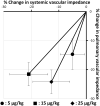Investigation of Beraprost Sodium on Cardiac Function and Hemodynamics in Canine Models of Chronic Pulmonary Hypertension
- PMID: 35498754
- PMCID: PMC9048895
- DOI: 10.3389/fvets.2022.876178
Investigation of Beraprost Sodium on Cardiac Function and Hemodynamics in Canine Models of Chronic Pulmonary Hypertension
Abstract
Pulmonary hypertension (PH) is a life-threatening disease in dogs characterized by increased pulmonary arterial pressure (PAP) and/or pulmonary vascular resistance. No study has evaluated the utility of Beraprost sodium (BPS) in dogs with PH. This study aimed to evaluate the effect of BPS on cardiac function and hemodynamics and examine the optimal dose of BPS in canine models of chronic embolic PH. In this prospective crossover study, three doses of BPS (5, 15, and 25 μg/kg, twice a day) were examined in eight canine models of chronic embolic PH. All model dogs underwent invasive PAP measurement, echocardiography, and non-invasive systemic blood pressure measurement before and after continuous administration of oral BPS for 1 week. No side effects of BPS were observed in any dog during the study. All doses of BPS significantly decreased systolic PAP and pulmonary vascular impedance. Additionally, systemic vascular impedance significantly decreased with 15 and 25 μg/kg of BPS. The right ventricular stroke volume and longitudinal strain significantly decreased with all doses of BPS. The left ventricular stroke volume and circumferential strain decreased with 15 μg/kg BPS. BPS was well-tolerated in this study. A dose-dependent vasodilating effect on pulmonary vessels was observed in canine models of chronic PH. Additionally, 15 μg/kg BPS showed a balanced vasodilating effect on systemic and pulmonary vessels. Furthermore, with a decrease in systemic and pulmonary vascular impedance, the left and right ventricular functions were significantly improved. Our results suggest that BPS may be useful in the treatment of canine PH.
Keywords: dog; myocardial function; pulmonary vascular resistance; pulmonary vasodilator; right ventricular strain; speckle tracking echocardiography; systemic vascular resistance.
Copyright © 2022 Suzuki, Yuchi, Saito, Teshima, Matsumoto and Koyama.
Conflict of interest statement
HK received a grant from Toray Industries, Inc. The remaining authors declare that the research was conducted in the absence of any commercial or financial relationships that could be construed as a potential conflict of interest.
Figures


Similar articles
-
Cardiovascular Effect of Epoprostenol and Intravenous Cardiac Drugs for Acute Heart Failure on Canine Pulmonary Hypertension.Vet Sci. 2023 Apr 19;10(4):302. doi: 10.3390/vetsci10040302. Vet Sci. 2023. PMID: 37104457 Free PMC article.
-
Beraprost Sodium for Pulmonary Hypertension in Dogs: Effect on Hemodynamics and Cardiac Function.Animals (Basel). 2022 Aug 15;12(16):2078. doi: 10.3390/ani12162078. Animals (Basel). 2022. PMID: 36009668 Free PMC article.
-
Comparative Study of Cardiovascular Effects of Selected Pulmonary Vasodilators in Canine Models of Mitral Valve Disease.Biology (Basel). 2024 Apr 30;13(5):311. doi: 10.3390/biology13050311. Biology (Basel). 2024. PMID: 38785793 Free PMC article.
-
Hemodynamic Phenotyping of Pulmonary Hypertension in Left Heart Failure.Circ Heart Fail. 2017 Sep;10(9):e004082. doi: 10.1161/CIRCHEARTFAILURE.117.004082. Circ Heart Fail. 2017. PMID: 28912263 Review.
-
Echocardiographic Evaluation of Pulmonary Pressures and Right Ventricular Function after Pediatric Cardiac Surgery: A Simple Approach for the Intensivist.Front Pediatr. 2017 Aug 29;5:184. doi: 10.3389/fped.2017.00184. eCollection 2017. Front Pediatr. 2017. PMID: 28900614 Free PMC article. Review.
Cited by
-
Cardiovascular Effect of Epoprostenol and Intravenous Cardiac Drugs for Acute Heart Failure on Canine Pulmonary Hypertension.Vet Sci. 2023 Apr 19;10(4):302. doi: 10.3390/vetsci10040302. Vet Sci. 2023. PMID: 37104457 Free PMC article.
-
Beraprost Sodium for Pulmonary Hypertension in Dogs: Effect on Hemodynamics and Cardiac Function.Animals (Basel). 2022 Aug 15;12(16):2078. doi: 10.3390/ani12162078. Animals (Basel). 2022. PMID: 36009668 Free PMC article.
-
Successful treatment of patent ductus arteriosus and severe pulmonary hypertension using sildenafil and beraprost sodium in two dogs.J Vet Med Sci. 2025 Jul 7;87(7):798-803. doi: 10.1292/jvms.25-0097. Epub 2025 May 26. J Vet Med Sci. 2025. PMID: 40414725 Free PMC article.
-
Comparative Study of Cardiovascular Effects of Selected Pulmonary Vasodilators in Canine Models of Mitral Valve Disease.Biology (Basel). 2024 Apr 30;13(5):311. doi: 10.3390/biology13050311. Biology (Basel). 2024. PMID: 38785793 Free PMC article.
-
Echocardiographic characteristics of dogs with pulmonary hypertension secondary to respiratory diseases.J Vet Intern Med. 2023 Sep-Oct;37(5):1656-1666. doi: 10.1111/jvim.16836. Epub 2023 Aug 18. J Vet Intern Med. 2023. PMID: 37593765 Free PMC article.
References
LinkOut - more resources
Full Text Sources
Research Materials

